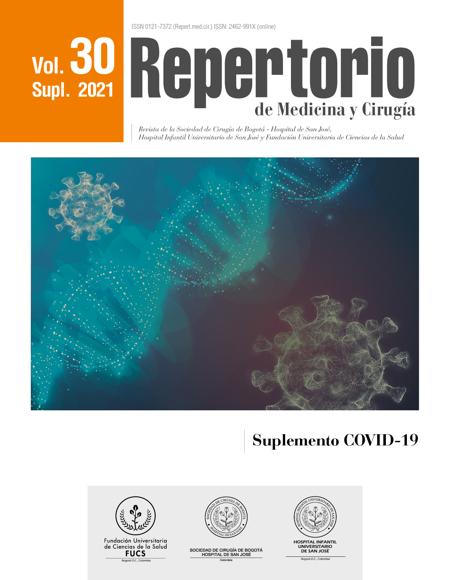Correlation between PCR and antigen tests and COVID-19 infection in Colombia
Correlación entre las pruebas PCR y Antígeno y el contagio por COVID-19 en Colombia
How to Cite
Download Citation
![]()
![]()

Show authors biography
Introduction: On December 2019, there was an outbreak of cases of unknown origin pneumonia, detected in Wuhan city, Hubei Province, China, currently known as COVID-19 disease. SARS-CoV-2 is transmitted from person to person contact and through secretions of infected persons, mainly respiratory droplets. Objective: to show if there is any correlation of PCR and antigen testing for COVID-19 and COVID-19 infections between January 1 and April 22 2021. Methodology: this research focused on the PCR and antigen samples processed for COVID-19 and the number of infections, using the data released by the National Institute of Health. Results: the p-value of the tests for variables PCR and antigen samples, and COVID-19 infections, which is 0.000, is less than α =0.01, thus the hypothesis (Ha) is accepted, that is Pearson´s correlation indicates there is a relationship between PCR and antigen tests for COVID-19 and the number of COVID-19 infections. Conclusion: the use of PCR and antigen tests is related with the number of COVID-19 infections, that is, as the values of PCR and antigen tests increase, the number of COVID-19 infections also increase and vice versa.
Article visits 3534 | PDF visits 1743
Downloads
- World Health Organization. Novel Coronavirus (2019-nCoV): situation report. World Health Organization; 2020. p. 7.
- Prompetchara E, Ketloy C, Palaga T. Immune responses in COVID-19 and potential vaccines: Lessons learned from SARS and MERS epidemic. Asian Pac J Allergy Immunol. 2020;38(1):1-9. doi: 10.12932/AP-200220-0772. DOI: https://doi.org/10.12932/AP-200220-0772
- Ministerio de Sanidad, Centro de Coordinación de Alertas y Emergencias Sanitarias. Información científica técnica. Enfermedad por coronavirus, COVID-19. Actualización 4 abril 2020. 2020. p. 111.
- Aguilar- Ramírez, P. Enríquez -Valencia, Y. Quiroz-Carrillo, Valencia- Ayala, C. De León-Delgado, J. Pareja-Cruz, A. Pruebas diagnósticas para la COVID-19: la importancia del antes y el después. Horiz. Med. 2020;20(2): e1231. doi: http://dx.doi.org/10.24265/horizmed.2020.v20n2.14 DOI: https://doi.org/10.24265/horizmed.2020.v20n2.14
- Adhanom, T. WHO Director-General’s opening remarks at the media briefing on COVID-19 [Internet]. World Health Organization; 2020 [citado 23 abril 2021]; Disponible en: https://www.who.int/director-general/speeches/detail/who-director-general-s-opening-remarks-at-the-media-briefing-on-covid-19---11-march-2020
- Arons MM, Hatfield KM, Reddy SC, Kimball A, James A, Jacobs JR, et al. Presymptomatic SARS-CoV-2 infections and transmission in a skilled nursing facility. N Engl J Med. 2020;382(22):2081-2090. doi: 10.1056/NEJMoa2008457 DOI: https://doi.org/10.1056/NEJMoa2008457
- Gandhi M, Yokoe DS, Havlir, DV. Asymptomatic Transmission, the Achilles’s Heel of Current Strategies to Control Covid-19. N Engl J Med. 2020;382(22):2158-2160. doi: 10.1056/NEJMe2009758 DOI: https://doi.org/10.1056/NEJMe2009758
- Hellewell J, Abbott S, Gimma A, Bosse NI, et al. Feasibility of controlling COVID-19 outbreaks by isolation of cases and contacts. Lancet Global Health. 20208(4):E488-E496. doi: 10.1016/S2214-109X(20)30074-7 DOI: https://doi.org/10.1016/S2214-109X(20)30074-7
- Meza Calvache J, Estrada Rodríguez A, Chabusa Martínez C, Velasco Paucar V. Utilidad de Pruebas de cadena de polimerasa, pruebas rápidas y Tomografías en pacientes con Covid-19. Journal of American Health. 2020;3(2):32-39. doi: https://doi.org/10.37958/jah.v3i2.28. DOI: https://doi.org/10.37958/jah.v3i2.28
- Soldevila-Langa, L. Valerio-Sallent, L. Roure-Díez, S. Interpretación de las pruebas diagnósticas de la COVID-19. FMC - Formación Médica Continuada en Atención Primaria. 2021;28(3):167-173. doi: 10.1016/j.fmc.2021.01.005 DOI: https://doi.org/10.1016/j.fmc.2021.01.005
- Organización Colegial de Dentistas de España. Test COVID-19 su evolución fiabilidad, utilidad y limitaciones. 2020. p. 18.
- Pita-Fernández, S. Pértega-Díaz, S. Relación entre variables cuantitativas [Internet]. Fisterra; 2021 [citado 23 abr 2021]; Disponible en: https://www.fisterra.com/formacion/metodologia-investigacion/relacion-entre-variables-cuantitativas/
- Suárez-Ibujes, M. Coeficiente de correlación de Karl Pearson [Internet]. 2021 [citado 23 abr 2021]; Disponible en: https://www.monografias.com/trabajos85/coeficiente-correlacion-karl-pearson/coeficiente-correlacion-karl-pearson.shtml
- Díaz-Pinzón JE. Estudio de los resultados del contagio por COVID-19 a nivel mundial. Repert Med Cir. 2020;29 (Núm. Supl.1):65-71. doi: 10.31260/RepertMedCir.01217372.1089 DOI: https://doi.org/10.31260/RepertMedCir.01217372.1089
- Díaz-Pinzón, J.E. Proyección del COVID-19 en Colombia. Rev. Med [Internet]. 11 de septiembre de 2020 [citado 19 de abril de 2021]; 28(1). DOI: https://doi.org/10.18359/rmed.4702 DOI: https://doi.org/10.18359/rmed.4702
- Díaz-Pinzón, J.E. Soporte técnico de simulación Phet en la enseñanza y aprendizaje de fracciones equivalentes. Revista de investigaciones Universidad del Quindío. 2016;28(2):31-41. doi: https://doi.org/10.33975/riuq.vol28n2.6 DOI: https://doi.org/10.33975/riuq.vol28n2.6
- Instituto Nacional de Salud. Coronavirus (COVID-19) en Colombia [Internet]. 2021 [citado 23 abr 2021]; Disponible en: https://www.ins.gov.co/Paginas/Inicio.aspx
- Pérez- Abreu M, Gómez-Tejeda J, Dieguez-Guach R. Características clínico-epidemiológicas de la COVID-19. Rev Haban Cienc Méd. 2020;19(2): e_3254.












